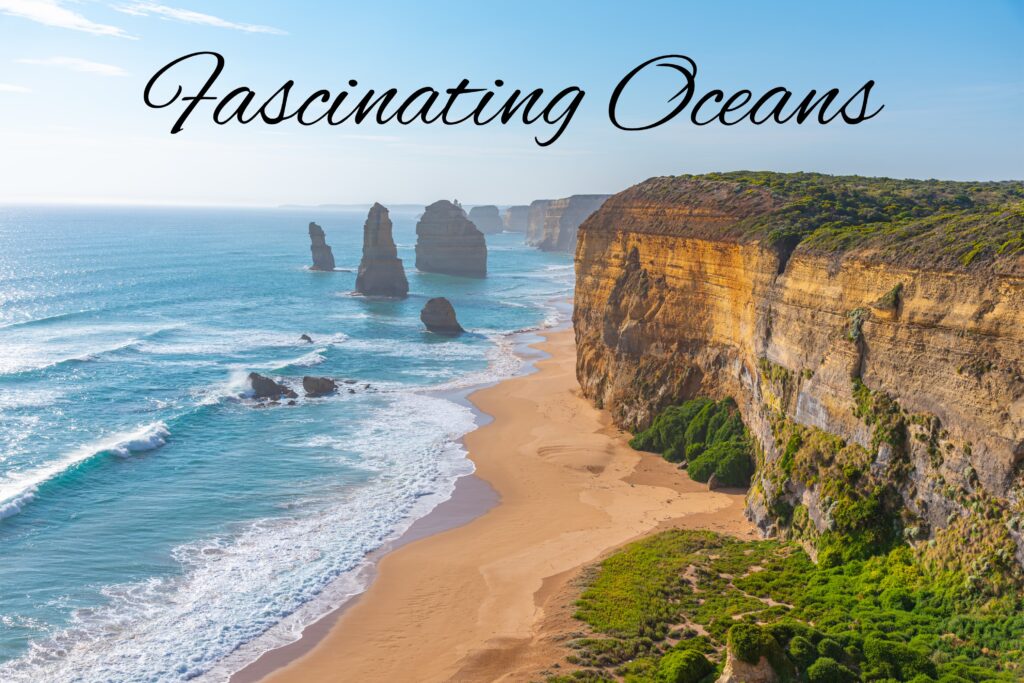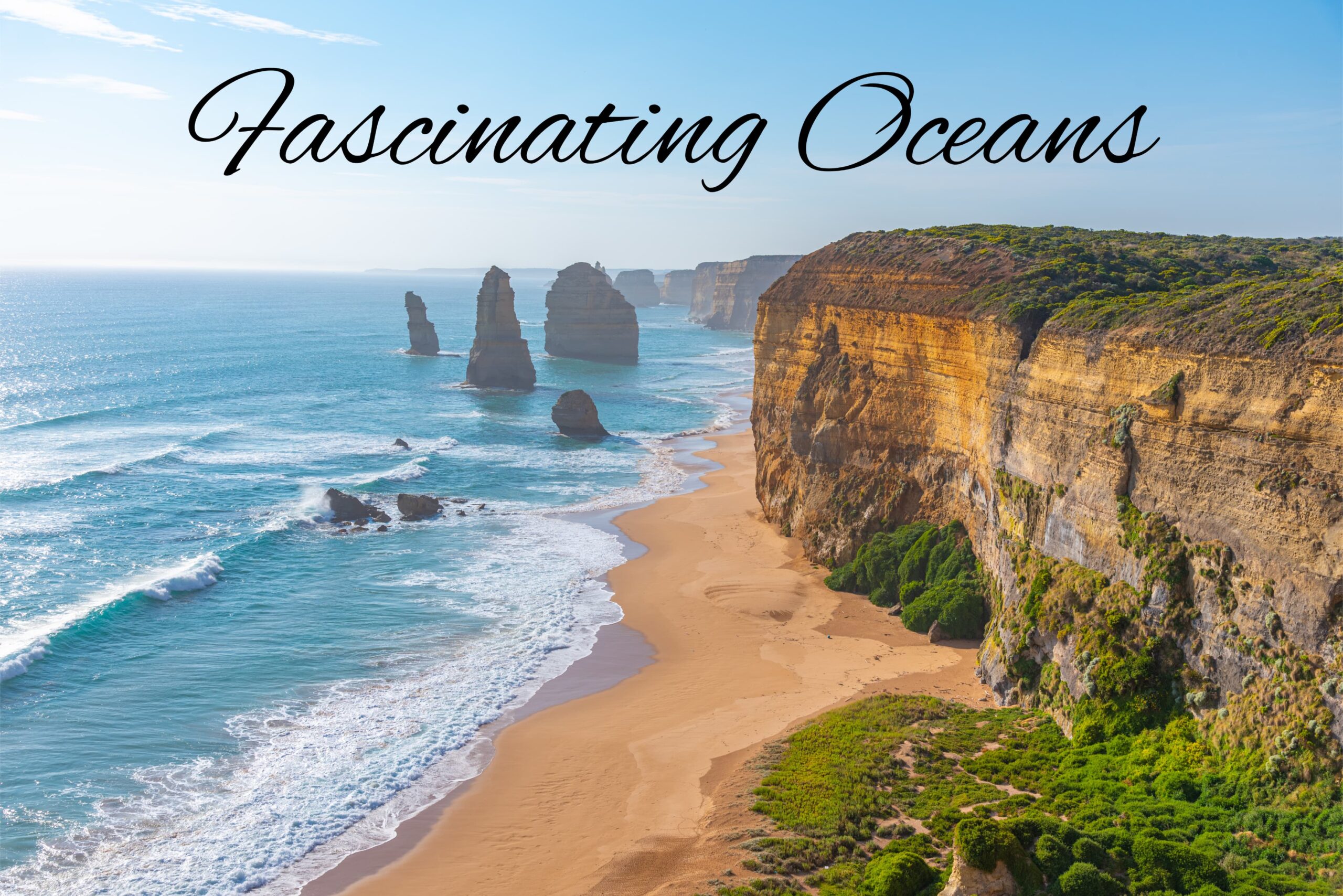The Earth’s oceans cover about 71% of its surface and play a vital role in climate regulation, marine biodiversity, and global trade. There are five main oceans:
1. Pacific Ocean
• Size: The largest and deepest ocean, covering about 63 million square miles.
• Location: Bounded by the Americas to the east, Asia and Australia to the west.
• Notable Features: Home to the Mariana Trench, the deepest point on Earth, and the Pacific Ring of Fire, an area with significant volcanic and seismic activity.
• Marine Life: Rich biodiversity, including coral reefs, migratory species, and deep-sea creatures.
• Economic Importance: Major shipping routes and fisheries.
2. Atlantic Ocean
• Size: The second-largest ocean, covering about 41 million square miles.
• Location: Between the Americas, Europe, and Africa.
• Notable Features: Divided by the Mid-Atlantic Ridge, an underwater mountain range.
• Marine Life: Known for rich fishing grounds and diverse ecosystems, including the Sargasso Sea.
• Historical Importance: Crucial in early exploration and trade routes, and a major site for transatlantic slave trade.
3. Indian Ocean
• Size: The third-largest ocean, spanning 27 million square miles.
• Location: Bounded by Africa, Asia, Australia, and the Indian subcontinent.
• Notable Features: Warmest ocean, home to vital monsoon systems influencing climate in South Asia.
• Marine Life: Important for coral reefs, migratory species like whales, and high biodiversity.
• Economic Importance: Key for oil transportation, as major shipping lanes pass through it, especially in the Persian Gulf.
4. Southern (Antarctic) Ocean
• Size: Surrounds Antarctica and covers about 7.8 million square miles.
• Location: South of 60°S latitude, surrounding the continent of Antarctica.
• Notable Features: Contains the powerful Antarctic Circumpolar Current, the world’s largest ocean current.
• Marine Life: Includes unique cold-water species, penguins, seals, and krill, crucial for global food chains.
• Environmental Importance: Regulates Earth’s climate and plays a key role in carbon sequestration.
5. Arctic Ocean
• Size: The smallest and shallowest ocean, covering about 5.4 million square miles.
• Location: Located in the Arctic region, surrounded by North America, Europe, and Asia.
• Notable Features: Covered with sea ice for much of the year, though this is rapidly diminishing due to climate change.
• Marine Life: Supports species adapted to cold, such as polar bears, seals, and Arctic cod.
• Geopolitical Importance: Increasingly important for shipping routes and potential oil and gas exploration as sea ice recedes.
Economic and Strategic Importance
Oceans are essential for global trade, with over 90% of international trade carried by sea. Fisheries, offshore oil drilling, and tourism provide livelihood for millions, but also lead to overexploitation of resources. The discovery of untapped natural resources, such as deep-sea mining potential, presents both opportunities and environmental challenges.
The world’s oceans are a vital and interconnected system, influencing global weather patterns, supporting rich ecosystems, and driving the world economy. However, they face significant threats, and urgent actions are needed to protect their future. Conservation efforts, sustainable use of marine resources, and tackling climate change are critical steps toward ensuring the health of the world’s oceans for generations to come.
Climate and Environmental Impact
All oceans are critical for regulating the Earth’s climate, acting as a heat sink and carbon storage system. The oceans are also under threat due to climate change, overfishing, and pollution. Rising sea levels, warming waters, and ocean acidification are global concerns with far-reaching consequences for both marine ecosystems and human populations.
Weather Patterns in the Oceans
Oceans play a critical role in regulating global weather patterns. They absorb vast amounts of solar energy, and this influences wind systems, storms, and rainfall. The El Niño and La Niña phenomena, driven by changes in ocean temperatures in the Pacific, have global consequences, such as droughts, floods, and shifts in monsoon patterns. The Indian Ocean Dipole also affects weather in countries like India and Australia, leading to fluctuating rainfall patterns.
• El Niño/La Niña: These are irregular climate phenomena that alter wind and water temperatures in the Pacific, impacting global weather patterns.
Fishing Patterns
Fisheries are heavily dependent on oceanic ecosystems and currents. Nutrient upwelling zones, like those found in the Peruvian coast, support large populations of fish like anchovies. In the Arctic and Antarctic oceans, ice melt is shifting fish populations, while overfishing in many regions has disrupted traditional fishing patterns. Technologies such as satellite monitoring and Fish Aggregating Devices (FADs) are used to track schools of fish, altering centuries-old fishing methods.
• Important Fishing Zones: The Bering Sea, North Sea, and Grand Banks are among the world’s most productive fishing areas.
• Overfishing Issues: A decline in major fish populations like cod and tuna has led to tighter regulations in many regions.
Maritime Trade
Maritime trade accounts for over 90% of global trade, with critical shipping lanes such as the Suez Canal, Panama Canal, and the Strait of Malacca being vital choke points. The Pacific and Atlantic Oceans host the busiest shipping routes, and the rise of containerization has revolutionized the global logistics industry. Global trade depends on the smooth operation of these maritime highways, making maritime security and freedom of navigation crucial.
• Top Ports: Shanghai, Singapore, Rotterdam, and Los Angeles are among the world’s busiest ports.
• Challenges: Piracy, especially in regions like the Horn of Africa and the Strait of Malacca, remains a major security issue.
Maritime Security
Oceans are increasingly becoming areas of geopolitical tension. Issues like territorial disputes in the South China Sea, where multiple nations lay claim to islands and shipping lanes, pose significant security challenges. Additionally, illegal fishing, piracy, and smuggling are persistent problems in many regions. Navies and coast guards around the world regularly patrol major shipping routes to ensure security.
• Key Geopolitical Flashpoints: South China Sea, Arctic waters (due to melting ice and new shipping routes), and the Strait of Hormuz.
• Piracy Hotspots: Somalia, Gulf of Guinea, and parts of Southeast Asia.
Marine Animals
Oceans are home to a diverse range of species, from tiny plankton to the largest mammals on Earth, such as the blue whale. Coral reefs, mangroves, and deep-sea vents host rich ecosystems, but climate change, overfishing, and pollution are driving many species toward extinction.
• Endangered Species: Species like the vaquita, leatherback turtle, and various sharks are critically endangered.
• Unique Ecosystems: Hydrothermal vent communities thrive in complete darkness, relying on chemosynthesis rather than photosynthesis.
Islands and Archipelagos
Oceans are dotted with thousands of islands, many of which are of volcanic origin. The Hawaiian Islands, Galápagos Islands, and Maldives are among the most famous. These islands are often biodiversity hotspots and have unique ecosystems. Rising sea levels, however, threaten many island nations, especially low-lying ones like Tuvalu and the Marshall Islands.
• Island Nations at Risk: Maldives, Kiribati, Tuvalu face existential threats from rising sea levels.
• Famous Island Ecosystems: Madagascar’s unique species evolved due to millions of years of isolation from the mainland.
Mysterious Islands
Throughout history, oceans have given rise to legends of mysterious islands, some real, some fictional. For example, Atlantis, though mythological, has captured the imagination for centuries. Real islands like Easter Island (Rapa Nui), famous for its monumental statues, remain enigmatic due to their isolated development. Other mysterious islands include Bouvet Island, a remote and uninhabited landmass in the South Atlantic Ocean.
• Enigmatic Islands: Easter Island, Socotra, Bouvet Island.
• Historical Mysteries: The disappearance of civilizations on islands like the Easter Island continues to intrigue archaeologists and historians.
Ocean Mysteries
The deep oceans hold many unsolved mysteries. The Bermuda Triangle, for example, has been linked to numerous disappearances of ships and planes, though scientific explanations often point to natural causes such as methane gas eruptions. Other unexplained phenomena include deep-sea anomalies like the Bloop sound detected in 1997, which scientists believe was caused by an icequake but remains an open mystery.
• Bermuda Triangle: An area between Florida, Bermuda, and Puerto Rico, infamous for disappearances.
• Oceanic Anomalies: Unexplained sounds like the Bloop and the 1991 Baltic Sea anomaly.
Impact of Climate Change on Oceans
Oceans are absorbing much of the heat from global warming, leading to rising sea levels, acidification, and more intense hurricanes and typhoons. Coral reefs, which support vast marine biodiversity, are particularly at risk due to coral bleaching caused by warmer waters.
• Sea Level Rise: Low-lying coastal areas and islands face increased risks of flooding and storm surges.
• Coral Bleaching: Major reef systems like the Great Barrier Reef have suffered significant damage due to rising temperatures and pollution.

Conclusion
Oceans are vital to the health of the planet, supporting intricate ecosystems, regulating weather, and facilitating global trade. However, they face numerous threats from overfishing, pollution, and climate change. The mysteries and wonders of the deep oceans continue to captivate scientists and explorers, while strategic, environmental, and economic issues underscore the importance of preserving these vast marine resources for future generations.
Resources for Further Exploration:
• National Oceanic and Atmospheric Administration (NOAA) – NOAA.gov
• United Nations Environment Programme (UNEP) on Oceans – UNEP Oceans
• World Wildlife Fund (WWF) on Oceans – WWF Oceans




